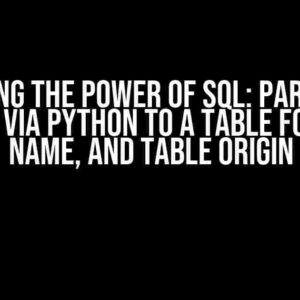Welcome to the world of character encodings, where the magic of Unicode and hexadecimal code points meet! In this article, we’ll embark on a thrilling adventure to tackle the challenge of converting Czech characters from UTF-8 HEX to a readable format in SQL. Buckle up, folks, and get ready to learn!
What’s the big deal about Czech characters?
Czech language, also known as Čeština, is a Slavic language spoken in the Czech Republic and other parts of Europe. It’s a beautiful language with unique characters, diacritical marks, and accents that can be a nightmare to handle in SQL. The Czech character set includes characters like Ě, Š, Č, Ř, Ž, and Ů, which are not part of the standard ASCII character set.
UTF-8 HEX: The secret code
UTF-8 (Unicode Transformation Format – 8-bit) is a variable-length character encoding that can represent every character in the Unicode character set. In SQL, we often encounter UTF-8 HEX codes, which are hexadecimal representations of Unicode characters. For example, the Czech character “ě” is represented as C48D in UTF-8 HEX.
| Czech Character | UTF-8 HEX Code |
|---|---|
| ě | C48D |
| Š | C5A0 |
| Č | C48C |
| Ř | C595 |
| Ž | C5BD |
| Ů | C49A |
Converting UTF-8 HEX to readable Czech characters in SQL
Now that we’ve got our UTF-8 HEX codes, let’s dive into the world of SQL and learn how to convert them to readable Czech characters. We’ll use a combination of SQL functions and clever string manipulation to achieve this feat.
Method 1: Using the CONVERT function
In SQL Server, we can use the CONVERT function to convert the UTF-8 HEX code to a readable Czech character. The syntax is as follows:
CONVERT(VARCHAR, CONVERT(VARBINARY, 'C48D', 2), 0) AS Czech_Character
In this example, we’re converting the UTF-8 HEX code C48D to the Czech character “ě”. The first CONVERT function converts the hexadecimal string to a VARBINARY data type, and the second CONVERT function converts the VARBINARY data to a VARCHAR data type, using code page 0 (the default code page).
Method 2: Using the UNHEX and CHAR functions
In MySQL, we can use the UNHEX function to convert the UTF-8 HEX code to a readable Czech character. The syntax is as follows:
CHAR(UNHEX('C48D')) AS Czech_Character
In this example, we’re using the UNHEX function to convert the UTF-8 HEX code C48D to a decimal value, and then the CHAR function to convert the decimal value to a readable Czech character “ě”.
Real-world examples and best practices
Now that we’ve learned how to convert UTF-8 HEX codes to readable Czech characters, let’s explore some real-world examples and best practices to keep in mind.
-
When working with Czech characters, it’s essential to use a Unicode-compliant database collation, such as UTF8_GENERAL_CI.
-
Use the correct character set and collation for your database and tables to ensure that Czech characters are stored correctly.
-
When converting UTF-8 HEX codes, use the correct code page and character set to avoid data corruption or loss.
-
Test your conversions and character encodings thoroughly to ensure that Czech characters are displayed correctly.
Common pitfalls and troubleshooting
Working with Czech characters and UTF-8 HEX codes can be challenging, and we’ll encounter some common pitfalls along the way. Here are some troubleshooting tips to help you overcome these obstacles:
-
Character corruption or loss: Check your character set, collation, and code page settings to ensure that they’re correct for Czech characters.
-
Incorrect conversions: Verify that you’re using the correct conversion function and syntax for your database management system.
-
Data truncation: Ensure that your database columns and data types can accommodate the length and complexity of Czech characters.
Conclusion
Converting Czech characters from UTF-8 HEX codes to readable characters in SQL requires a deep understanding of character encodings, Unicode, and hexadecimal code points. By mastering this skill, you’ll be able to work with Czech language data efficiently and accurately. Remember to use the correct character set, collation, and code page settings, and don’t hesitate to test and troubleshoot your conversions thoroughly. With practice and patience, you’ll become a master of Czech character encoding in no time!
So, the next time you encounter a mysterious UTF-8 HEX code, you’ll be ready to decode it and extract the beautiful Czech character hidden within. Happy coding, and may the character encoding force be with you!
Here are 5 Questions and Answers about “SQL – Czech character encoding from UTF-8 HEX” with a creative voice and tone:
Frequently Asked Question
Get ready to decode the mystery of Czech character encoding from UTF-8 HEX in SQL!
What is the difference between UTF-8 and HEX encoding in SQL?
UTF-8 is a character encoding that can represent every character in the Unicode character set, while HEX encoding represents each character as a hexadecimal value. In SQL, UTF-8 is used to store text data, while HEX is used to store binary data.
How do I convert Czech characters from UTF-8 to HEX in SQL?
You can use the `UNHEX()` function in SQL to convert UTF-8 encoded Czech characters to HEX. For example, `SELECT UNHEX(‘č’)` would return the HEX value `C48D`.
What is the advantage of using HEX encoding for Czech characters in SQL?
Using HEX encoding for Czech characters in SQL ensures that the characters are stored and retrieved accurately, without any loss of data or corruption. This is especially important when working with non-ASCII characters like č, ď, and Ě.
Can I use HEX encoding for Czech characters in all SQL databases?
While most SQL databases support HEX encoding, the specific implementation may vary. Make sure to check the documentation for your specific database management system (DBMS) to ensure compatibility.
How do I convert HEX encoded Czech characters back to UTF-8 in SQL?
You can use the `HEX_TO_UTF8()` function in SQL to convert HEX encoded Czech characters back to UTF-8. For example, `SELECT HEX_TO_UTF8(‘C48D’)` would return the UTF-8 encoded character `č`.




